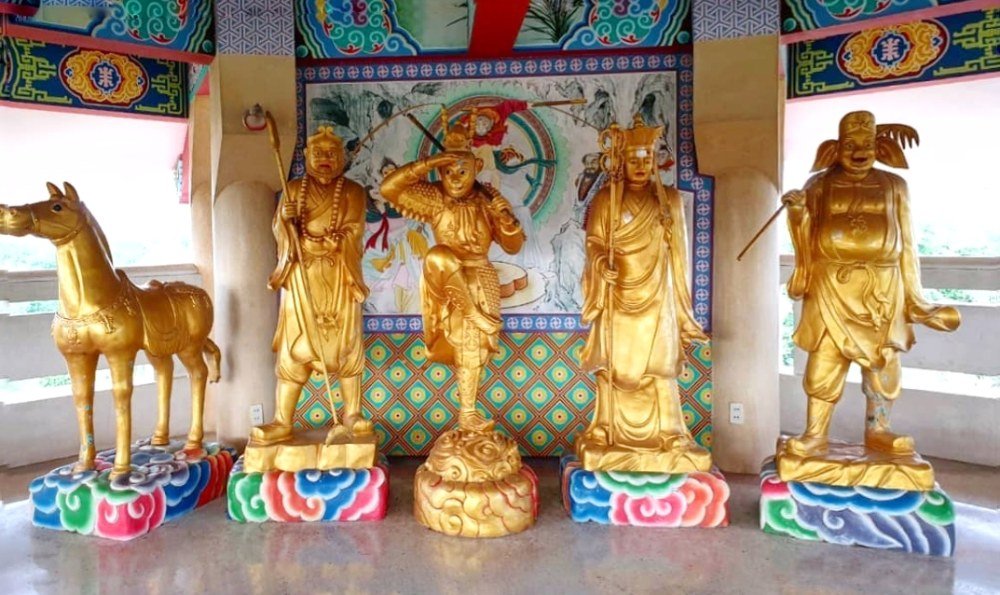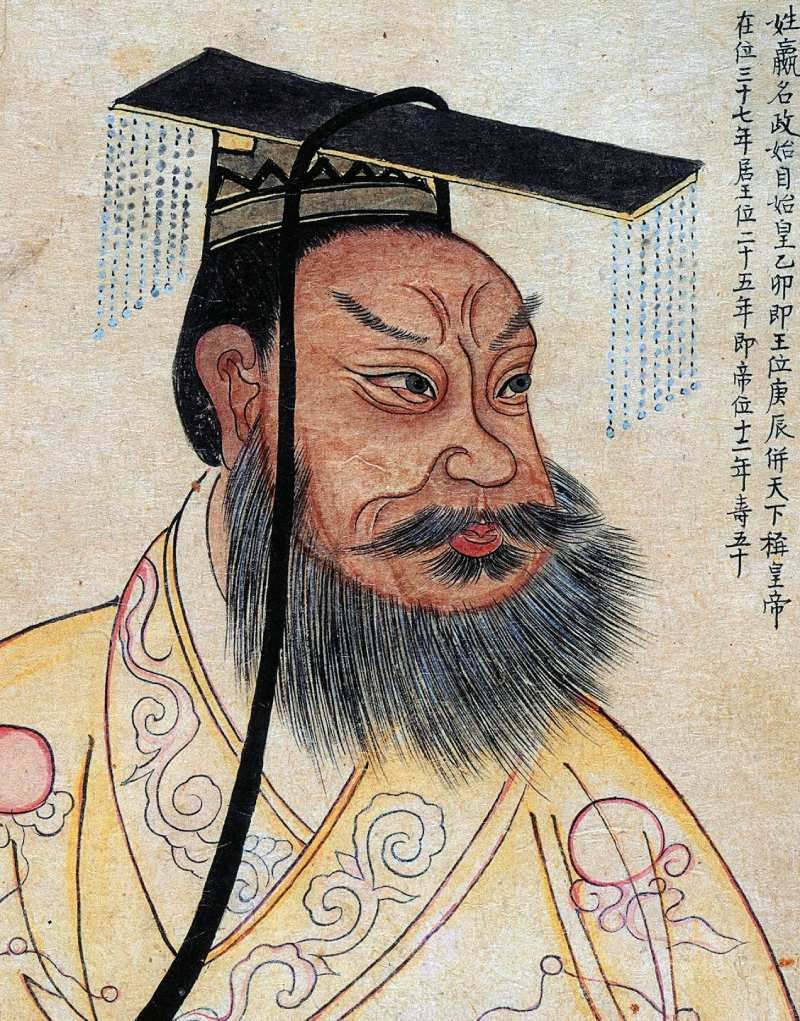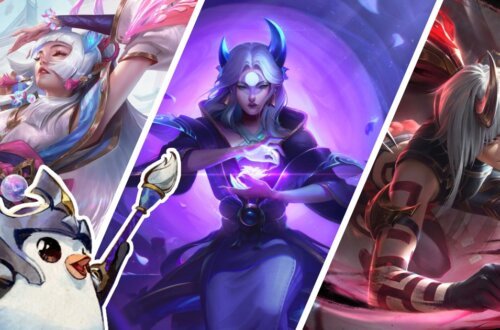
TFT Set 11: The Fascinating Lore in Inkborn Fables (1/4)
When I launched my first game in TFT Set 11, I could immediately tell how much Chinese mythology had influenced Inkborn Fables.
From the art style to the music, it’s a big celebration of Chinese and East Asian culture and tradition.
As a big fan of Asian culture, I eagerly delved into this set’s ancient Chinese motifs. My mission? To uncover the roots of the 11 origin traits in Inkborn Fables.
And, boy, did I find some good stuff.
This first installment examines the Mythic, Heavenly, and Storyweaver traits, revealing the ancient Chinese myths and literature that inspired them.
Expect fantastical creatures, epic heroes, and a few fun historical facts to discuss the next time you play TFT duos with another cultured geek.
Mythic

When early humans began taking shelter in caves, they used basic pigments and carving techniques to depict stories on the stone walls. You might call these the original “Inkborn Fables.”
This human ability to tell stories through evocative pictures drives the Mythic trait and perhaps the entirety of TFT Set 11.
Awesome as it sounds, Riot didn’t take inspiration from ancient petroglyphs for the Mythic trait. Instead, they went for traditional Chinese painting and illustration.
Note: While Western artists favored oil-based paint for their artwork, ancient Chinese masters preferred water-based ink. This gave their art, often painted on silk or paper, a dreamlike look.
The World Inside a Painted Scroll
The cosmetic skins Riot chose for the Mythic units come from the Shan Hai Scrolls continuity within the League of Legends multiverse.

Like the Painted World of Ariamis in Dark Souls, the Shan Hai Scrolls depict a living, breathing universe within a painting.
Note: Instead of framing their artwork, Chinese artists used to roll up their work into scrolls. This makes them portable and allows you to control how elements are viewed as the scroll is rolled out.
Scores of mythical creatures roam magical landscapes inside the Shan Hai Scrolls. These include nature gods like Bard, river dragons like Tahm Kench, and voracious monsters like Cho’gath.
Luckily for us lore researchers, the inspiration for the Shan Hai Scrolls is apparent. After all, it’s in the name.
Ancient Chinese Beasts and Where to Find Them
Most of what we know of ancient Chinese mythology comes from a single source: the Classics of Mountains and Seas, also known as the Shanhai Jing.
This massive compendium describes over 550 mountains and 300 water channels throughout China and the fabulous creatures that inhabit them—pictures included.
Think of it as the Fantastic Beasts and Where to Find Them of the ancient Chinese world. From nine-tailed foxes to nine-headed phoenixes, it’s all in the Classics of Mountains and Seas.
Note: Some magical beasts depicted in J.K. Rowling’s book (and later, the movie) come straight from the Shanhai Jing. These include the Qilin and the Zouwu.

The Shanhai Jing is so ancient that it’s impossible to pinpoint precisely who wrote it and when.
The present form of the Classics was completed during the early Han dynasty (circa 202 BCE), but early versions might have existed since the 4th Century BCE.
Let me put things into perspective. What we know as “China” was established by Qin Shi Huang (formerly King Ying Zheng) in 221 BCE after conquering six neighboring kingdoms to form an empire.
In other words, the Shanhai Jing was old even to the ancient Chinese.
Heavenly

While the inspiration for Set 11’s Mythic trait is obvious, the Heavenly origin leaves more room for interpretation.
Luckily, this gives me an excuse to talk more about Chinese mythology.
The Lunar Goddess Chang’e Theory
Our first clue comes from the cosmetic skins Riot chose to dress up most Heavenly champions. These are the Lunar Empress and Lunar Guardian lines released in 2023.
The term “Lunar Empress” reminds me of the Lunar Goddess Chang’e, who dwells on the moon with her pet rabbit, Yu Tu.
According to the Shanhai Jing, Chang’e ascended to the heavens after taking an immortality potion meant for her husband, the legendary archer Hou Yi.
While some tales accuse Chang’e of stealing the potion, the Shanhai Jing says she drank it to keep would-be thieves from immortality.

The Chinese celebrate her ascension during the Mid-Autumn Festival, held on the 15th day of the 8th month of the lunisolar calendar (Autumn equinox). In 2024, that would be September 17th.
During the festival, the people bake mooncakes—a favorite of the Goddess—and lay them out as offerings for Chang’e. They also burn incense and pray for good fortune in the coming year.
Note: Similar festivals are held all over Asia around the Autumn equinox. This includes Korea’s Chuseok and Japan’s Tsukimi.
Only one Heavenly champion carries the Lunar Empress title: Qiyana. This earns her the honor of being TFT Set 11’s Chang’e.
But if Qiyana plays the role of Chang’e, who’ll play her pet rabbit, Yu Tu?
Also known as the Jade Rabbit, this loyal pet followed Chang’e to guard and serve her eternally. How he achieved that without an immortality potion is mysterious, but that’s beside the point.
In Set 11, Kha’Zix and Maphite wear their “Lunar Guardian” skins. This title matches Yu Tu’s job description, so we can go ahead and cast them both for the role.

However, this interpretation leaves out the most potent Heavenly unit: the 5-cost Wukong.
The Journey to the West Theory
LoL’s Wukong is based on the Monkey King Sun Wukong, one of the main heroes of Wu Cheng’en’s 16th-century novel Journey to the West.
In the story, Sun Wukong is described as a mystical monkey who acquired incredible power through Taoist practices.
Note: Taoism is a Chinese philosophy/religion that can be (very) roughly described as “going with the flow.” It’s about accepting continuous change and living harmoniously within it.
Some of Sun Wukong’s powers include moving as fast as a shooting star, carrying mountains on his shoulders, and transforming into other animals.
During the story, we also see him acquire the Ruyi Jingu Bang, a magical staff that can change its size. You can see Wukong wielding the same staff in League of Legends and Teamfight Tactics.
Such enormous powers eventually earned Sun Wukong two titles: “Great Sage” and “Heaven’s Equal.”
These titles are inherited by TFT Set 11’s Wukong through his traits: Great / Heavenly / Sage.
Although he’s the biggest badass in Journey to the West, the novel isn’t about him—at least, not exclusively.

Instead, he’s one of Buddhist monk Tang Sanzang’s three followers, along with the pigman Zhu Bajie and the ogre Sha Wujing.
Together, the four embark on a quest to bring a collection of Buddhist scriptures from India back to China. This is the titular “journey to the west.”
Note: Buddhism spread to China from India and Central Asia during the Han dynasty (206 BCE—220 CE). It profoundly influenced Chinese culture and beliefs and remains China’s largest recognized religion.
Considering their monstrous appearances, we can comfortably cast Maphite and Kha’Zix as Zhu Bajie and Sha Wujing. This leaves only Tang Sanzang.
And that’s where Soraka comes in.
Riot chose to portray Set 11’s Soraka in her Immortal Journey skin. You could call it an aesthetically-driven creative decision, but I think they’re hinting at her role in this Heavenly play.
And so, Soraka, Kha’zix, Maphite, and Wukong set out to retrieve the holy scriptures…
Storyweaver

It’s hard to overstate the power of a good story.
Heroic tales like Journey to the West can inspire us to surpass our limits, find our inner strength, and even create works of art.
And that’s what the Storyweaver trait is all about.
The Tale of Kayle’s Immortal Journey
Storyweaver units are portrayed in Mythmaker skins, which belong in the Storycraft universe.
In this alternate storyline, Mythmaker Zoe uses magic to send her companions (Caitlyn, Camille, Gwen, Seraphine) into the Tale of the Great Beast Galio.
Note: With large wings and talon-like feet, the Great Beast Galio looks like the Vermillion Bird Zhu Que, one of the Four Holy Beasts in Chinese mythology. This phoenix-like creature governs the Southern skies, and it’s associated with Summer, fire, and rebirth.
This gives the tale’s characters (Galio, Garen, Irelia, Sivir, Zyra) a chance to rewrite the story and change their destinies—for better or worse.

In TFT Set 11: Inkborn Fables, Zoe uses her magic for something entirely different.
Instead of rewriting the Tale of the Great Beast Galio, Zoe and the tale’s characters (plus Riven) work together to bring a new hero to life: Kayle.
But what’s the Tale of Kayle about?
Judging by the name of her cosmetic skin, it’s an Immortal Journey.
The quest to achieve immortality is one of the oldest tropes in fiction.
It’s the central theme in the Epic of Gilgamesh—the oldest written story known to man.

This heroic epic is loosely based on Sumerian King Gilgamesh, who ruled over Uruk (modern-day Iraq) around 2700 BCE. The cuneiform stone tablets recounting his exploits date back to 2100 BCE.
That’s right: humans have been retelling the same story for over 4,000 years. Think about that when Disney decides to shoot a live-action remake of Toy Story.
Ancient China’s Obsession with Immortality
You can find plenty of stories relating to immortality in East Asian tradition as well.
Here are just a few examples from works we’ve already covered:
- Moon Goddess Chang’e ascended to the heavens only after drinking an immortality potion (or pill, depending on the version).
- Sun Wukong’s main reason for leaving his Monkey Kingdom and traveling the world was to find the secret of immortality.
- Tang Sanzang had to watch his back because people (and other creatures) believed that eating his flesh would make them immortal.
My all-time favorite Chinese tale of pursuing immortality comes not from myth or literary fiction but from the life of Qin Shi Huang—the first Emperor of China.

According to the ancient Chinese historian Sima Qian, the Emperor spent his final years obsessed with achieving immortality.
He sent expeditions to find mystical mountains, scoured the land for magical items, and consulted with alchemists to develop an immortality potion.
Regrettably, his obsession might have shortened his life.
Instead of a green kale smoothie or some spirulina, the Emperor was advised to drink a potion made of cinnabar—a beautiful red stone made of highly toxic mercury sulfide.
Note: Picture the Philosopher’s Stone from Harry Potter or Fullmetal Alchemist, but toxic and lacking any magical properties whatsoever.
He also commissioned the creation of the Terracotta Army. This collection of over 8,500 full-sized stone soldiers, chariots, and horses would, in theory, serve him after death.
You know, in case the mercury potion didn’t work.

It is unclear what he hoped to achieve with an army in the afterlife. Still, they contributed to immortalizing him as a near-mythical figure.
The moral of the story?
No miracle supplement can replace a healthy diet, physical activity, and regular check-ups with a licensed physician.
The Remaining Inkborn Fables
Most people will click off an article when the little scrollbar to the right of their screen gets too small.
In other words, it pays to keep things short.
We’ve already covered three of TFT Set 11’s eleven origin traits, but there’s still more lore to discover.
Click here to check out the other three parts of our Inkborn Fables analysis.



